#so sometimes you hibernate a project because you are anxious about not having the 'right' level of skill to complete it for instance
Explore tagged Tumblr posts
Text
Honestly, going into your WIP pile to actually go through it and see what you actually want to finish can be really helpful, especially when you don't judge yourself and try to learn why that piece became a hibernater in your WIP pile
Some questions I ponder when I look at a WIP is:
Is this project turning out how I want? If not, what about it don't I like?
Do I or did I have fun when I was starting it?
Will I actually use it or enjoy it when I'm done?
Do I like the material now?
Do I see myself enjoying the product after it's done?
Were there, or are there, time restraints preventing me from finishing?
Is this out of my current skill set, and am I okay with that?
If I could change one thing about the WIP, what would it be?
I know plenty of people won't incorporate this into their own WIP and crafting journey, and that's okay. But I know so many people who hibernate their projects for many reasons and feel guilty about it. I hope this might give people ideas about why they hibernate projects to prevent that type of guilt from eating away at their conscious. This (creating) should be fun, and if you're spending a lot of time feeling guilty or ashamed, it can be hard to continue doing the things you like.
#art#fiber art#knit#crochet#(but this applies to a Lot of crafts and skills and whatnot. i direct it towards knit and crochet because that's what i had in mind)#honestly i think i'm going to frog one of my WIPs because i just don't want it anymore#i don't like the pattern or the method it calls for and i don't like the acrylic material it recommended either#freeing yourself in the way you keep and permanently retire a WIP can be really healing i think#because then you can accept that you have the *right* to refuse to complete something which doesn't spark joy#i think many times people hibernate projects which spark anxiety or frustration for whatever reason#so sometimes you hibernate a project because you are anxious about not having the 'right' level of skill to complete it for instance#that's a generalization but i found personally that exploring *why* i hibernate things can lead me where i want to be...#...and lead me to explore what it is that fulfills my creativity in the way it needs to be honed#there is NOTHING wrong with never finishing or frogging a piece. in fact i implore you to do it if you want
38 notes
·
View notes
Text
What are some actually GOOD Sword and Sandal movies?
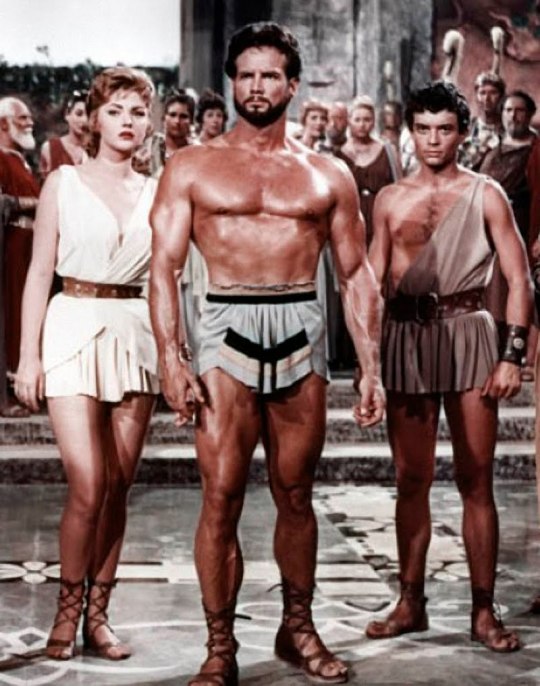
One of the bigger genres in Italy who’s popularity came and went in waves from the silent era to the present, Sword and Sandal (or Peplum) films are Italian movies about gladiators, musclemen, Ancient Greece and Rome, and who’s main characters include Hercules, Spartacus, Ursus, Maciste (a homegrown, semi-Marxist Hercules who fights the rich and decadent who is purely a creation of Italian cinema).
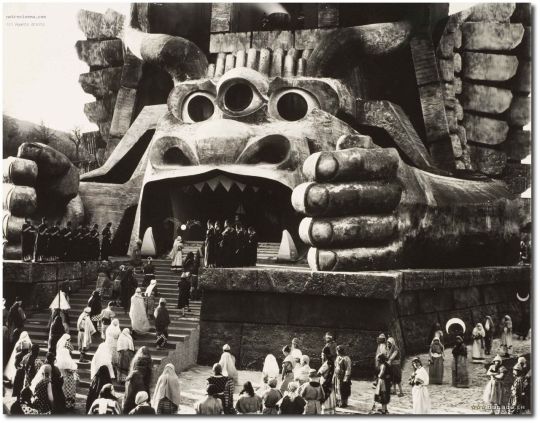
The genre started in 1912, with Cabiria, an ultra-early Italian feature that predated D.W. Griffith, featuring a muscular African slave named Maciste, and due to his muscles and screen presence, Bartolomeo Pagano may have been the first true movie star, making dozens of sequels. The popularity of these movies went into hibernation in Italy until 1959, when it got a huge resurgence when Steve Reeves starred as Hercules, and consequently became the highest paid star in Europe. Hercules (1959) caused literally hundreds of movies to be made, assembly line, in a burst of about 5 years. The genre burned itself out through repetition in only a half decade, only to be replaced by the Italian horror/slasher film and the Spaghetti Western. It was down for good, only to have something of a resurgence of popularity in Italy in the wake of the popularity of John Milius’s Conan the Barbarian in the early 1980s.

Sword and Sandal seems to be a genre where any given film picked at random could be a Mystery Science Theater 3000 episode. For the most part, Sword and Sandal movies are mostly known for being the training ground of people who showed their skills in other genres, like how Mario Bava became a horror director, or how Sergio Leone, a second unit director on a few, was best known later for Spaghetti Westerns. And there is certainly some truth to the idea that, if you have seen one, you’ve seen them all. But there are certainly some good examples of the genre that are worth seeing.
Goliath and the Dragon (1960)
Don’t be fooled, this is a Hercules movie, but they renamed it because of some begobbled distribution rights issue.
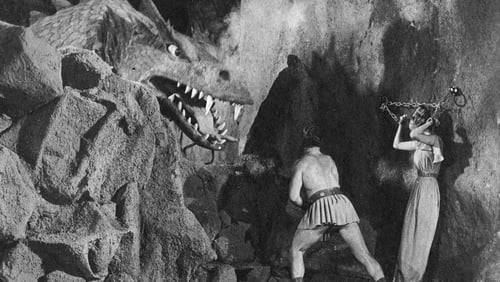
If you were a Greek mythology kid (and most nerdy kids went through a phase they were into sharks, dinosaurs, Greek mythology, AV/Radio, writing in Dwarf runes under your desk after reading Tolkien for the first time, and lego) you might remember reading about Hercules’s semi-tragic end, poisoned and killed by his own wife and a centaur. It was the most fascinating story, where Hercules’s great strength and courage was defeated by jealous and anxious little people who tore him down. Americans don’t have much of a taste for tragedy, so it’s very seldom been adapted for American audiences.

Goliath and the Dragon is that story. It literally starts with Hercules finishing his hardest heroic Labor, and retiring. However, his younger brother is jealous of him, and a conspiracy of schemers work to get rid of Hercules by manipulating envy. Along the way, Hercules feels abandoned by the gods and he turns against them in anguish after a lifetime of service. It has a dragon, and quests into the underworld, yes, but it is primarily not an adventure film, which is what makes it interesting.
It also stars Mark Forest, who might be the only one of the bodybuilders to play Hercules to have a legit screen presence. He later left movies to become an opera singer and voice coach.
Eric the Conqueror (1961)

This is one by Italian horror titan Mario Bava, and because it’s kind of a well known film, it actually has a half-decent transfer, including availability in the original language instead of a shoddy 70s dub - this is utterly, absolutely unheard of in this genre, where the copies of these movies on streaming (even on Amazon Prime!) are sometimes literally off VHS and have “snow lines” and other phenomenally half-assed signs of VHS transfer, like the original FBI WARNING stickers.
The film is about two Viking brothers, one of who is raised by Christians as a knight, the other of whom grows up the son of a pagan Viking warlord. It’s a film about the contrast between Christian and Pagan, and the one thing about it people remember is that it stars a pair of Playboy Playmate twins. Stylish and action-oriented with lots of red blood, it’s like a cool version of Disney’s “The Island at the Top of the World.”
Hercules in the Haunted World (1961)
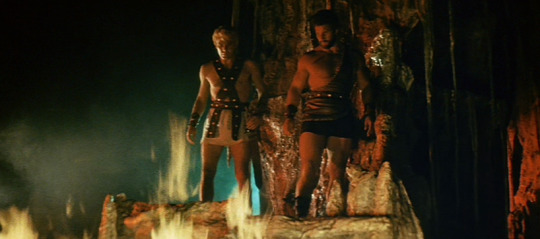
Hercules vs. Christopher Lee –need I say more? Christopher Lee is a vampire who took over a kingdom and hypnotized Hercules’s true love, shrouding the land in eerie darkness…and so Hercules has to descend into the underworld. This is a case where the screenshots really tell the story, they get across the eerie, surreal Gothic ambiance of the film. It doesn’t actually feature Castle Greyskull, but it would perfectly fit in with the décor.
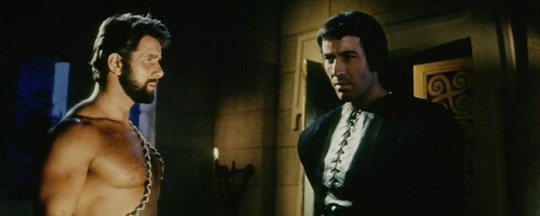
As far as I know, Hercules never actually encountered vampires in Greek folklore, but in Italian cinema, they seem to feel that the supreme challenge for the Son of Zeus is the undead (see also, Kobrak in Goliath and the Sins of Babylon).

I feel guilty having two Mario Bava movies on here. But of the two, this one feels the more…Mario Bava, in lighting, design, and ambiance, which is really the reason to see it. Essentially, it’s Hercules Goes to Hell, and it’s treated as more of a truly eerie horror movie, with weird lighting. The presence of Christopher Lee makes it feel like a bodybuilder accidentally wandered onto the set of a Hammer Horror film, with crumbling castles and she-vampires in negligees.
Maciste in Hell (1925)

Speaking of the essential plot of a muscleman going to hell, you wouldn’t think a movie of that kind would be whimsical, charming, imaginative, and creative, but it is. Satan tries to tempt Maciste, a pure in heart muscleman who represents the pure, incorruptible goodness and strength of the working class. Maciste movies, distinct from Hercules films, always had a strong Marxist undertone, with villains who were super-rich and decadent, all the while Maciste resisted their temptations and hung out with the lower classes and sponsored a revolution. The movie is full in intertitles like “the Dragon – Hell’s Aeroplane!” And the quest by female devils to turn Maciste into a demon himself with a kiss. Essentially, it’s a movie where if you’re pure in heart and have biceps of steel, there’s no problem you can’t bench press, grip, or grapple, even Satan.
According to his memoirs, this was the movie that made Fellini want to become a director.
Hercules and the Princess of Troy (1965)
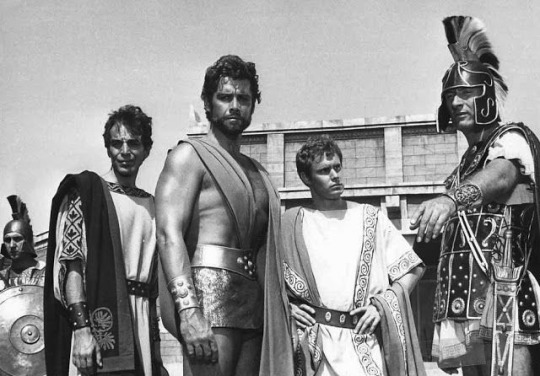
Made at the absolute dying gasp of the genre, this one is essentially the “Enter the Dragon” of Sword and Sandal movies, in that it was a Hollywood/Italian co-production, much like how “Enter the Dragon” was the first Hollywood/Hong Kong co-production. It wasn’t a movie at all, but a pilot episode for a television show that never went to series…to everyone’s shame, because if it had been made, it would have been a crowd pleaser, if the pilot was anything to go by. I all but guarantee it would be a syndication favorite that would have turned everyone in it into a star, the kind that would be on Nick at Nite forever, or the earliest incarnation of F/X, where it was just a scrappy rerun network with a pre-Survivor Jeff Probst (I still remember the F/X house all the VJ like hosts lived in).
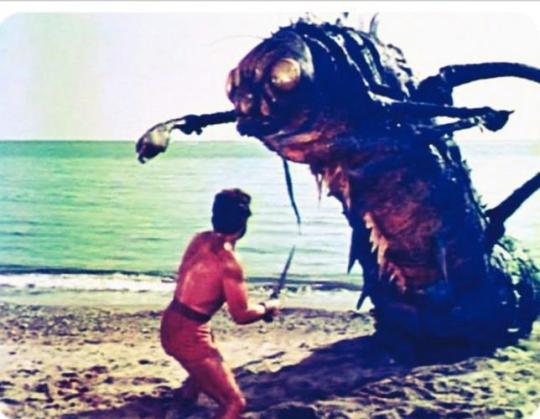
This one has Hercules (played by Tarzan Gordon Scott) as a sea captain and leader of a Greek ship named the Olympia, who is accompanied by two sidekicks, Ulysses (a young, clever Ulysses as Herc’s sidekick was also a trait of Paul Levine’s Hercules and Hercules Unchained), and Diogenes, Hercules’s smart friend, a medical doctor and proto-scientist who comes off as the project’s most interesting character, a Dr. McCoy like curmudgeon who adventures to stay away from his awful wife, who creates a chemical that burns on water and who uses the Socratic Method to solve a murder mystery. If this had gone to series, I can see him overshadowing the theoretical leading man in a similar way to Jonathan Harris as Dr. Smith overshadowing the Robinsons.
The pilot was great fun. It had mythological creatures like invulnerable horses and a terrifyingly unique sea monster, that was some of the earliest work by the now legendary Carlo Rambaldi (creator of E.T. and the Alien) that is light years ahead of the shag carpet dragons musclemen pretend to wrestle in movies like this. Not to mention a mystery, and Hercules facing intrigue that, as a trustworthy and direct man of action, he is incapable of dealing with (a trait of nearly every single interesting Hercules movie).
415 notes
·
View notes